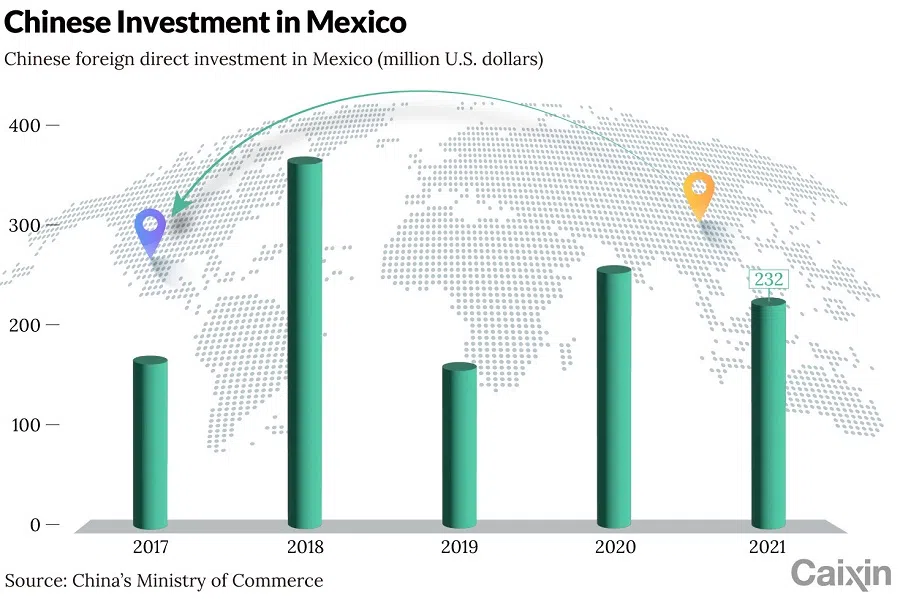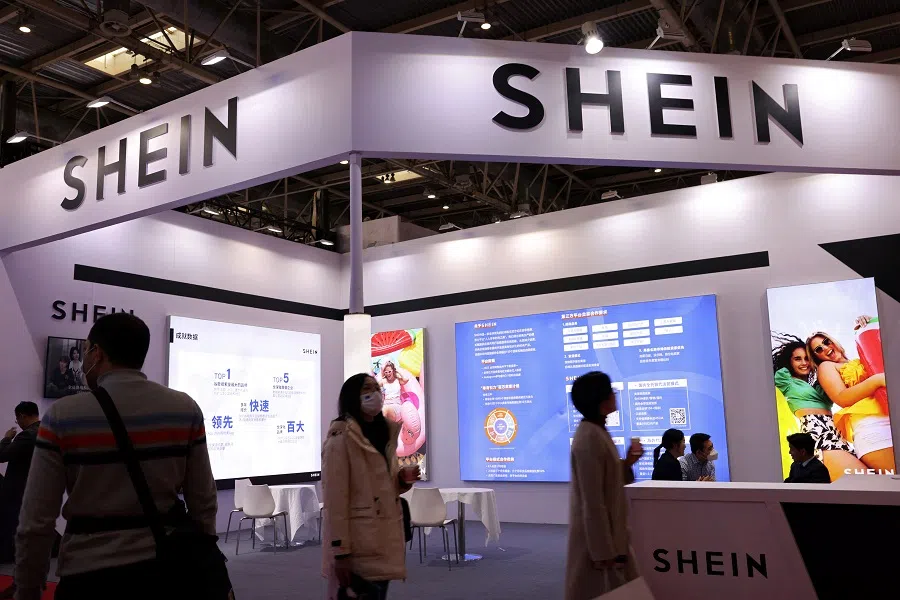China-Latin America ties deepen amid boom in cross-border auto trade, e-commerce
China has been Latin America's second largest trading partner since 2012, and last year total bilateral trade reached a record high of US$486 billion. Against the backdrop of the ongoing friction between Beijing and Washington, and the latter's push for nearshore trade, Mexico has been the biggest beneficiary.

(By Caixin journalists Li Rongqian, Bao Yunhong, Yu Cong and JZhang)
Twenty-five kilometres north of Monterrey, Mexico, is a cluster of Chinese-owned factories producing everything from auto parts and mechanical equipment to electronics and furniture.
The site, Hofusan Industrial Park, has seen some 30 Chinese firms set up shop in the past four years. But Hofusan is only one part of a much bigger picture, as more and more Chinese companies searching for new markets turn their attention to Latin America.
China has been Latin America's second largest trading partner since 2012, and last year total bilateral trade reached a record high of US$486 billion.
Against the backdrop of the ongoing friction between Beijing and Washington, and the latter's push for nearshore trade, Mexico has been the biggest beneficiary, with total trade increasing 9.8% year-on-year to reach US$95 billion in 2022, according to the Trade Development Bureau of China's Ministry of Commerce.
China's foreign direct investment in Mexico also rose from US$171 million in 2017 to US$232 million in 2021, according to latest figures released by the ministry.
The export of cars and auto parts has long been a highlight of China's trade with Latin America. But e-commerce has quickly become a mainstay of China's presence in the region...

The North American Free Trade Agreement signed by the US, Mexico and Canada also means that companies can export certain products made in Mexico to the US with zero tariffs.
Among the latest firms to set up operations in Mexico are Chinese suppliers of Tesla Inc., after the US electric vehicle (EV) maker announced plans to build a giant factory in the country.
Leading Chinese carmakers including BYD Co. Ltd. and Chery Automobile Co. Ltd. have also been mulling building factories in Mexico, while Great Wall Motor Co. Ltd. and Chongqing Changan Automobile Co. Ltd. are also considering setting up there, Caixin understands.
The export of cars and auto parts has long been a highlight of China's trade with Latin America. But e-commerce has quickly become a mainstay of China's presence in the region, which is witnessing online consumer growth at a rapid clip.
Retail e-commerce sales in Latin America is expected to grow 14.3% this year, up from a 11.9% growth last year, led by a strong performance in Argentina, Mexico and Colombia, according to data from market research firm Insider Intelligence in an October report.
And as in Southeast Asia, Chinese e-commerce platforms have staked a claim in the local market, with Brazil and Mexico being the main entry points.
Although growth in the region has been declining, the International Monetary Fund in October lifted its 2023 economic growth estimate for Latin America and the Caribbean to 2.3% from 1.9%...

In April, China-founded fast-fashion retailer Shein announced it was launching manufacturing operations in Brazil, its first stop in Latin America. AliExpress, Alibaba's cross-border e-commerce unit, announced in October that it would continuously ramp up investment in the Brazil market.
PDD Holdings Inc.'s Temu, an e-commerce platform popular in the US, has launched in Mexico and quickly gained traction. Short-video app Kuaishou has also begun offering e-commerce services in Brazil in the first quarter this year.
Chinese companies have good reason to be enthusiastic about Latin America. Although growth in the region has been declining, the International Monetary Fund in October lifted its 2023 economic growth estimate for Latin America and the Caribbean to 2.3% from 1.9%, citing stronger-than-expected growth in Brazil and Mexico.
EV manufacturing
Mexico is the seventh largest car producer in the world, rolling out 3.5 million vehicles every year, 88% of which were for export, according to the US International Trade Administration. Global giants such as Ford Motor Co., General Motors Co., Toyota Motor Corp., Volkswagen AG and BMW AG have all established a presence in the country.
In March, Tesla announced that its fifth factory would be built in Monterrey. So far, Lens Technology Co. Ltd. and Ningbo Tuopu Group Co. Ltd., two Tesla suppliers, have settled in Hofusan Industrial Park.
"Tesla may have three suppliers for a part in China, and whoever comes out first gets to 'eat' the market first," said Hu Hai, who runs the industrial park.

Currently, most Chinese carmakers are just exporting to Mexico. But some, including state-owned giant BAIC Motor Corp. Ltd., have already set up assembly plants locally. BYD is considering building an EV factory in Mexico after announcing plans to open a plant in Brazil, the company told Bloomberg in September, while Chery Auto executives met with Mexico's Undersecretary of Foreign Trade Alejandro Encinas Najera last December over potential plans to establish manufacturing facilities in the country.
Brazil and Mexico rank as the first and second largest car markets in Latin America respectively. Both are open to the import of new-energy vehicles (NEV). The Mexican government has rolled out incentives such as zero tariffs on imported vehicles, reductions in tolls and parking fees, hoping that the proportion of zero-emission vehicles can increase to 50% of all cars produced in the country by 2030.
JAC Motors was one of the first Chinese carmakers to sell NEVs in Mexico, starting in 2019. This year, BYD began selling NEVs in the country in March, followed by Great Wall Motors in September.
Brazil has also exempted import duties on electric cars and halved the levy on plug-in hybrid models - a key opportunity for Chinese carmakers. In the first five months of 2023, Brazil imported over 10,000 China-made NEVs, the most of any Latin American country, according to data provided to Caixin by the automobile branch of the China Chamber of Commerce for Import & Export of Machinery and Electronic Products.
Cross-border e-commerce takes off
Shein launched in Mexico in 2019 and Brazil in 2020 and is growing at a rapid clip. Its sales in Brazil in 2022 reached 8 billion reais (about US$1.6 billion), up 300% from a year ago, according to Brazilian investment bank BTG Pactual. The company is also planning to ship products it makes in Brazil to other Latin American markets from 2026, according to the company.
Livestreaming e-commerce has good prospects in Brazil, said a person familiar with Latin American e-commerce, adding that some people are already keen to setup local multi-channel networks - companies that work with influencers across a variety of platforms.
Temu, on the other hand, is still a newcomer, entering the Mexican market in May and subsequently launching in Chile at the end of August. But the platform has taken root quickly, with data from Sensor Tower showing Temu as the top downloaded free app on Apple and Google's app stores in Mexico every day in the past month.

Temu has been highly popular in Mexico since June, according to Lin Wei, general manager of e-commerce at 360Lion, a Chinese cross-border logistics service provider focusing on Latin America. The company sees 50,000 to 60,000 orders per day on average in Mexico, and nearly 100,000 orders on peak days, Li told Caixin in September.
Other Chinese e-commerce platforms are doubling down on Latin America. AliExpress increased its investment in 2023, enhancing product offerings, offering heavy discounts and establishing overseas warehouses. It entered Chile as well, and as of the first quarter this year had a 42% share of the Chilean cross-border e-commerce market, surpassing Amazon and Shein, according to Chile-based consultancy Kawes Lab.
Insider Intelligence predicted in an October report that TikTok will become the fastest-growing social platform in Latin America with a user growth rate of 11.8% in 2023. At the same time, Kuaishou's app Kwai "has strong momentum in Brazil and is very similar to its domestic strategy in China, focusing on the sinking market," one person familiar with TikTok's strategy said, referring to third-tier cities and below.
Kwai's current business is mainly advertising and livestreaming, the person said. The company also revealed in its 2022 annual report that it has been exploring overseas e-commerce business opportunities.
Livestreaming e-commerce has good prospects in Brazil, said a person familiar with Latin American e-commerce, adding that some people are already keen to setup local multi-channel networks - companies that work with influencers across a variety of platforms.

But cross-border sellers face a number of big headaches in Latin America, one of which is the timely fulfillment of orders. The region is renowned for lengthy and strict customs processes, while local logistics services remain underdeveloped, said Kent, co-founder of Mexico-based cross-border logistics company Saleasy.
There are incidents of logistics companies mixing customs-compliant goods with sensitive goods without stating so, leading to the risk of goods being detained by customs authorities and affecting deliveries, one cross-border seller in the Mexican market told Caixin.
In Brazil, high and complex tariffs are the biggest concern for cross-border e-commerce, according to multiple people in the sector. Imported goods with a value between US$50 and US$3,000 cleared through Brazilian Post must pay a fixed import tax. Meanwhile, the country's federal system means a circulation tax is payable for goods sent between states.
Therefore, the Chinese companies that are building factories in Latin America are mainly state-owned enterprises, listed companies, or large private enterprises. Some of the earliest Chinese entrants to the region were major white goods manufacturers such as Gree Electric Appliances Inc of Zhuhai, Midea Group Co. Ltd. and Hisense Home Appliances Group Co. Ltd.
China's increased exports and investments to Latin America have driven new demand for maritime logistics, driving up freight rates and leading shipping companies to open new routes to the region.
Logistics bottlenecks
China's increased exports and investments to Latin America have driven new demand for maritime logistics, driving up freight rates and leading shipping companies to open new routes to the region.
The freight price for a 20-foot shipping container from Shanghai to Santos, a major seaport in Brazil, was US$2,300 in August, up more than 110% from a low in January, according to the Shanghai Containerized Freight Index published by the Shanghai Shipping Exchange.
But since 2022, shipping companies including Maersk, Mediterranean Shipping Co. Ltd., CMA CGM SA and COSCO Shipping Holdings Co. Ltd. have all opened new routes between East Asia and Latin America, which is building downward pressure on freight rates.

Compared with shippers that can quickly open new routes, it is not as easy for logistics and freight forwarding companies to enter the Latin American market, with lengthy customs clearance times a major obstacle, according to Lin at 360Lion.
Many areas of the region also have relatively underdeveloped infrastructure. About 70% of the roads in Latin America and the Caribbean are not paved as of end of 2021, according to a Huatai Securities Co. Ltd. report, and of the 20 countries with the worst railway infrastructure in the world, ten are in Latin America, including Brazil.
Crime is also a concern. In Mexico, there is risk of goods being stolen, making the purchase of insurance and security for goods commonplace, said the cross-border vendor in the Mexican market.
This article was first published by Caixin Global as "In Depth: China-Latin America Ties Deepen Amid Boom in Cross-Border Auto Trade, E-Commerce". Caixin Global is one of the most respected sources for macroeconomic, financial and business news and information about China.





![[Big read] China’s 10 trillion RMB debt clean-up falls short](https://cassette.sphdigital.com.sg/image/thinkchina/d08cfc72b13782693c25f2fcbf886fa7673723efca260881e7086211b082e66c)